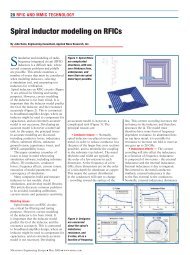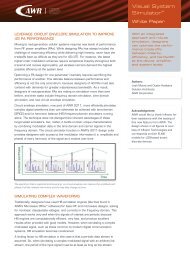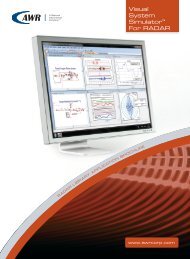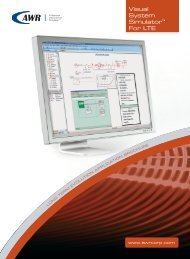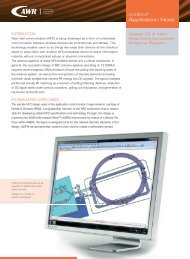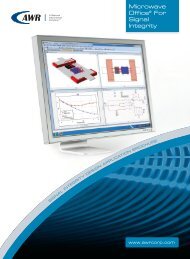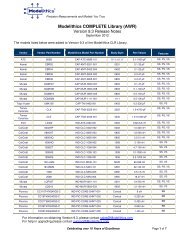MRHB™ White Paper
MRHB™ White Paper
MRHB™ White Paper
Create successful ePaper yourself
Turn your PDF publications into a flip-book with our unique Google optimized e-Paper software.
AWRMRHB<strong>White</strong> <strong>Paper</strong>A technique called “multi-tone harmonic balance analysis” was developed that made it possible toconsider analyzing receivers and transmitters. These early harmonic balance engines incorporateddirect matrix methods that were very useful in steady-state analysis of a circuit with a fewtransistors. However, when they were presented with larger nonlinear circuits, the resulting denseconversion matrices devoured computer memory and required many hours of simulation time.In the 1990s, harmonic balance technology got a much-needed boost when numerical analysistechniques appeared that were better-suited for solving large nonlinear problems. Direct matrixtechniques were supplemented with iterative techniques and the naïve Newton iteration wasreplaced by so-called inexact Newton methods. The use of more advanced and better optimizedfast Fourier transform (FFT) techniques produced great advances in how nonlinear devicecomputations were performed.A NEW OBSTACLEHarmonic balance has been a true enabler of steady-state nonlinear analysis with distributedelements, but as the number of tones (independent frequencies) increases, the number ofmathematical unknowns that must be solved grows geometrically. This occurs because in a multitonesystem, each circuit element must be solved not just at the harmonics of each tone, but alsoat many of their linear combinations as well. If the designer cannot constrain the harmonic balanceanalysis engine by limiting the number of frequency combinations per circuit element, the circuitmust be analyzed for the same frequencies at every circuit node. In a typical multi-tone circuit, forexample, this means that a lot of CPU time is consumed to refine a zero.The number of analysis frequencies becomes a bottleneckwhen the number of tones grows above three, a phenomenonappropriately labeled by the numerical analysis community asthe Curse of Dimension. Table 1 helps clarify the ramificationsof the “curse,” and demonstrates what happens even in amoderately nonlinear simulation when the number of tones isincreased. When fortified with the increased accuracy produced Table 1. The Curse of Dimension.by “diamond truncation” (the strategy of selecting frequencylinear combinations), the growth in the number of frequencies and hence the number of unknownsto be solved is almost an order of magnitude for every tone. This presents an untenable situationthat renders most current harmonic balance solutions ineffective as they are faced with processingextraordinary amounts of information in order to achieve a result.AN INNOVATIVE NEW APPROACH - MRHBTo understand the sea change enabled by MRHB, it is important to remember its core concept:that operational blocks such as mixers, filters, and amplifiers in an RF system modify thefrequency content. As traditional harmonic balance techniques assume that the relevant frequencycontent will be the same at every part (or block) in the circuit, it is essentially “out of sync” withhow the circuit actually functions. Rather than perpetuating this concept, MRHB enables thedesigner to allow different parts of the circuit to have different dominating frequencies, andtakes into consideration that some frequencies are important to solve while others are not. Thisintelligent, frequency-selective technique makes it possible to solve very complex circuits such asreceivers with multiple stages of downconversion, multi-band power amplifiers, and complex highfrequencydigital designs, an order of magnitude faster than with traditional harmonic balance.



